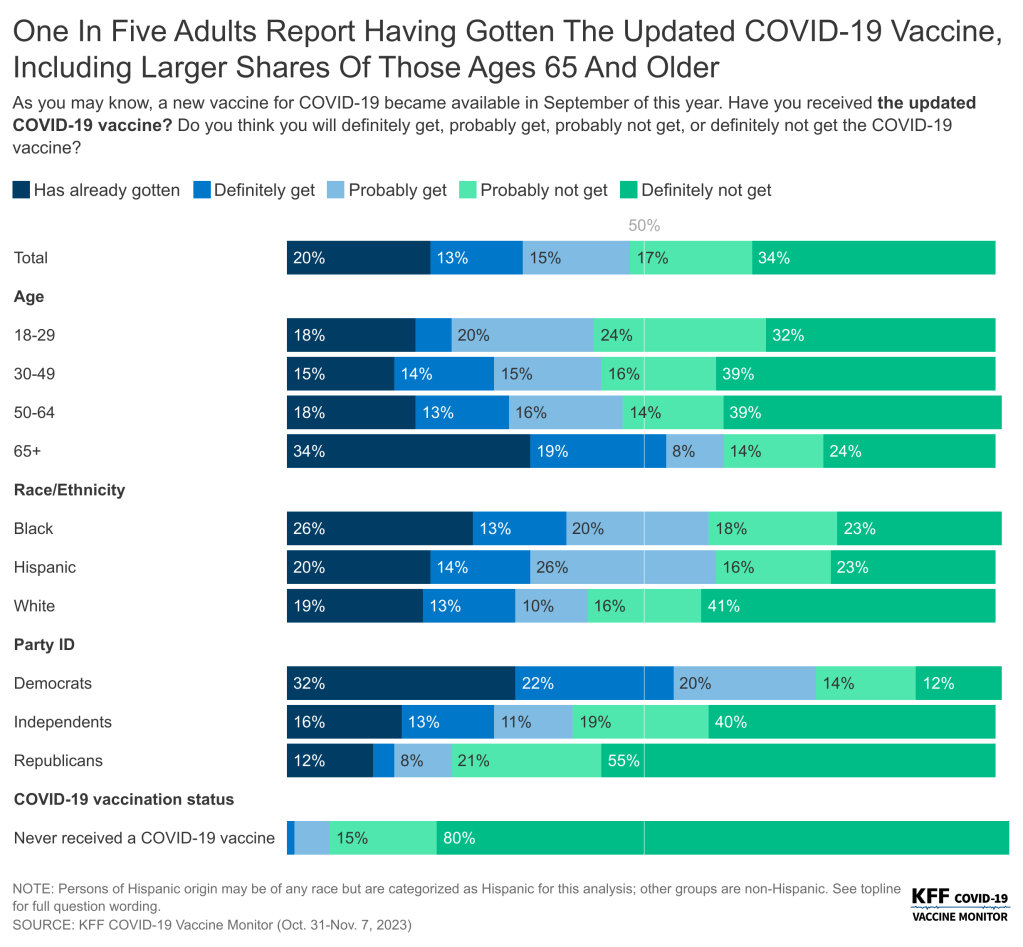[ad_1]
The most recent KFF COVID-19 Vaccine Monitor survey unearths that part (51%) of all adults nationally say they “surely” or “most probably” is not going to get the newest COVID-19 vaccine, with many announcing that they aren’t fearful about catching the virus.
One in 5 (20%) say that they’ve already gotten the brand new vaccine that become to be had in September, with an extra 28% announcing they “surely” or “most probably” gets the brand new shot. The remainder say they “surely” or “most probably” is not going to get the brand new shot – a big workforce that comes with three-in-10 (31%) of all adults who up to now were given a COVID vaccine however now say they don’t plan to get the up to date vaccine.
Maximum Black adults (59%) and Hispanic adults (59%) say they’ve both already gotten the vaccine or be expecting to get the brand new vaccine. Against this, maximum White adults (58%) say they “surely” or “most probably” is not going to get it. Partisanship additionally continues to play an oversized position in vaccine attitudes. As an example, eight-in-10 (80%) White adults who determine as Republicans say they don’t plan to get the brand new vaccine – greater than two times the proportion of White adults who determine as Democrats (29%).

Amongst up to now vaccinated adults who’ve no longer but gotten newest vaccine, part (52%) cite a loss of fear about getting the virus as a reason why. Fewer say being too busy (37%), ready to get it later (32%), or having had dangerous negative effects after a prior dose (27%) are all explanation why they haven’t gotten the brand new shot.
About one-in-six (16%) say that they may be able to’t have enough money to take time without work paintings to get the vaccine, together with greater than a 3rd (35%) of Hispanic adults and one-in-five (22%) Black adults. About one-in-eight (13%) cite no longer with the ability to get a vaccine appointment as a reason why for no longer getting the brand new shot.
Heading into the fourth vacation season since COVID-19 emerged, most of the people aren’t too fearful about its doable affect on themselves or their pals and households, the survey displays.
For example, 3 quarters (74%) of the general public say that they’re “no longer too fearful” or “under no circumstances fearful” about getting COVID-19 over the vacations, nearly 3 times the proportion who’re “very” or “rather” fearful (26%). No less than two- thirds (68%) say that they don’t seem to be fearful about spreading the virus to other folks with regards to them, greater than two times the proportion who’re fearful (31%).
The general public is divided on precautions being taken as a result of COVID-19 this autumn and wintry weather. Part (50%) of the general public plans to take no less than considered one of 5 doable precautions to cut back their dangers all the way through the autumn and wintry weather: Warding off huge gatherings (35%); dressed in a masks in crowded puts (30%); fending off commute (25%); fending off indoor eating places (19%); or taking a COVID-19 take a look at ahead of visiting friends and family (18%). The opposite part plans to take none of the ones precautions.
People who find themselves no less than 65 years previous – a bunch particularly liable to critical COVID-19 sickness – are some of the in all probability to mention that they’ve already gotten the brand new vaccine (34%), even though they’re no much more likely than more youthful adults to mention that they plan to take no less than one of the crucial 5 precautions.
Black (72%) and Hispanic (68%) adults are a lot more most probably than White adults (39%) to mention they plan to take no less than a type of precautions. In a similar fashion, Democrats (66%) are greater than two times as most probably as Republicans (29%) to mention they plan to take precautions.
Designed and analyzed via public opinion researchers at KFF, the survey was once performed from October 31-November 7, 2023, on-line and via phone amongst a nationally consultant pattern of one,401 U.S. adults. Interviews have been performed in English and in Spanish. The margin of sampling error is plus or minus 4 proportion issues for the overall pattern. For effects in line with different subgroups, the margin of sampling error could also be upper.
[ad_2]
Source link
